Article Directory
The Real Reason a Detroit Baseball Stadium Is Changing Its Name
You might have seen the headlines and shrugged: Fifth Third, Comerica enter $10.9B deal, will likely rename Tigers' home. Another day, another corporate merger. The kind of news that makes eyes glaze over, relegated to the back pages of the business section. But I want you to look closer, because buried in the talk of stock premiums and deposit shares is a story that isn't about banking at all. It's about the relentless, invisible tide of technology and what it takes to survive in the world that tide is creating.
The most visible sign of this shift won't be on a balance sheet; it'll be painted on the side of a baseball stadium in Detroit. Comerica Park, a name etched into the city's lexicon since 2000, will likely be rebranded by 2027. Imagine standing in the crowd, the roar of a home run echoing under a new name, a name that tells a story of adaptation. This isn't just a logo swap. It’s a tombstone for an old way of doing business and a birth announcement for a new one.
Comerica, a bank with roots stretching back to 1849 Detroit, a survivor of the Great Depression, is merging its way into the future. And the reason why tells us everything we need to know about where our world is headed.
An Alliance Forged by Code
Let’s be brutally honest. This merger wasn't a choice; it was an inevitability. When I read that this massive, landscape-altering deal for two regional banking pillars came together in just two weeks, I had to read the line again. That’s not the speed of careful deliberation. That’s the speed of necessity. It’s the kind of velocity you see when an external force is so powerful, so undeniable, that your only option is to react.
That force is technology.
Comerica CEO Curt Farmer said it himself: "At $78 billion, we are one of the smaller regional banks... the need to invest in technology, the need to invest in branch expansion, marketing, branding, product capabilities and more client-facing personnel, all that is harder when you’re a bank our size." This is the kind of quote that keeps me up at night, because it’s the quiet, honest truth of our era. For decades, a bank was a building, a vault, and a trusted relationship. Now, a bank is a mobile app, a cybersecurity shield, an AI-driven fraud detection system, and a seamless digital interface—and the cost of building and maintaining that technological fortress is astronomical.

This merger is like watching two master craftsmen, each with a renowned local workshop, realizing they can no longer compete with the massive, automated factory down the road. They can’t afford the same state-of-the-art machinery on their own. So, they decide to pool their resources, knock down the wall between their shops, and build their own factory. This isn't about gobbling up a competitor for market share—it’s about achieving the raw scale needed to fund the technological arms race against behemoths like J.P. Morgan Chase and the nimble fintech startups chipping away at their foundations.
Look at the numbers. Comerica’s stock return was a paltry 6.9% over the last seven years, while Fifth Third’s was 106%. That isn't just a story of performance; it's a story of scale. Without the capital to pour into innovation, you stagnate. You become a relic. So what does this stunningly fast merger really represent? It’s the moment the boardrooms finally acknowledged that their biggest competitor isn't the bank across the street, but the code being written in Silicon Valley.
The Human Cost of a Digital Future
Of course, building this new, bigger, more technologically advanced machine isn't without friction. The plan involves closing overlapping branches. For the combined company, this is about efficiency—pruning the network, as one CEO put it. But for us, on the ground, it raises a critical question. What happens to the neighborhoods, particularly in less affluent or rural areas, when their local bank branch disappears? This is the central tension of the 21st century: how do we embrace the incredible efficiency of technological progress without leaving people behind?
This consolidation feels almost like a historical echo. Think of the early 20th century, when hundreds of small, independent automobile manufacturers were either acquired or went bust, eventually coalescing into the "Big Three." It was a brutal, chaotic process, but it was the only way to achieve the scale needed for the assembly line, the paradigm shift of its day. We are seeing the financial industry's assembly line moment, and this merger is a key part of it.
This is the kind of breakthrough that reminds me why I got into this field in the first place. It forces us to ask the big questions. Is this the first major domino in a great consolidation of American regional banking? Are we witnessing a fundamental rewiring of our financial infrastructure, where only the largest, most technologically integrated players can survive? And as customers, what do we demand from the banks of tomorrow? A branch on every corner, or an unhackable, intuitive supercomputer in our pocket? I suspect the answer is the latter, and Fifth Third and Comerica are betting their combined future on it.
This Isn't Consolidation, It's Adaptation
Let's call this what it is. This isn't the sad story of a historic brand being swallowed by a bigger fish. This is the story of two institutions looking at the horizon, seeing the tsunami of technological change, and deciding to build a stronger ship together. It’s a proactive, intelligent, and necessary move to prepare for a future where banking is defined not by marble columns, but by elegant, secure, and powerful code. This is evolution in action.
